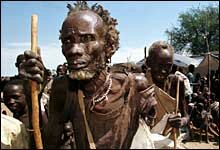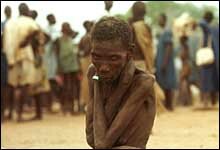|
Hosanna's diary
19.03.31: HOSANNA was eight years old when she died. Her tiny face, mummified by starvation, was indistinguishable from that of any other victim of the famine.
She was not only one in a million but one in tens of millions, hardly more than a speck on the face of Africa.
Her destiny should have been to remain anonymous, and yet hers was the story that stirred the conscience of the world. It is a story that exists only in fragments; even her home village can't be identified from the pictures. We know only that it was close to Uganda's northern border.
Were it not for a single, unremarkable chance event, her death would have passed with as little notice as her birth. On her fifth birthday somebody gave her a turn-of-the-century camcorder and a bagful of cassettes. The result is one of the most humbling records of this century.
The poignancy of the diary is heightened by its contrast with earlier images on the recycled tapes which she only partially over-recorded. Spliced into her pictures of despair are surviving fragments from the lives of the camcorder's first owners - a prosperous English family captured in various states of posing and play.
|






